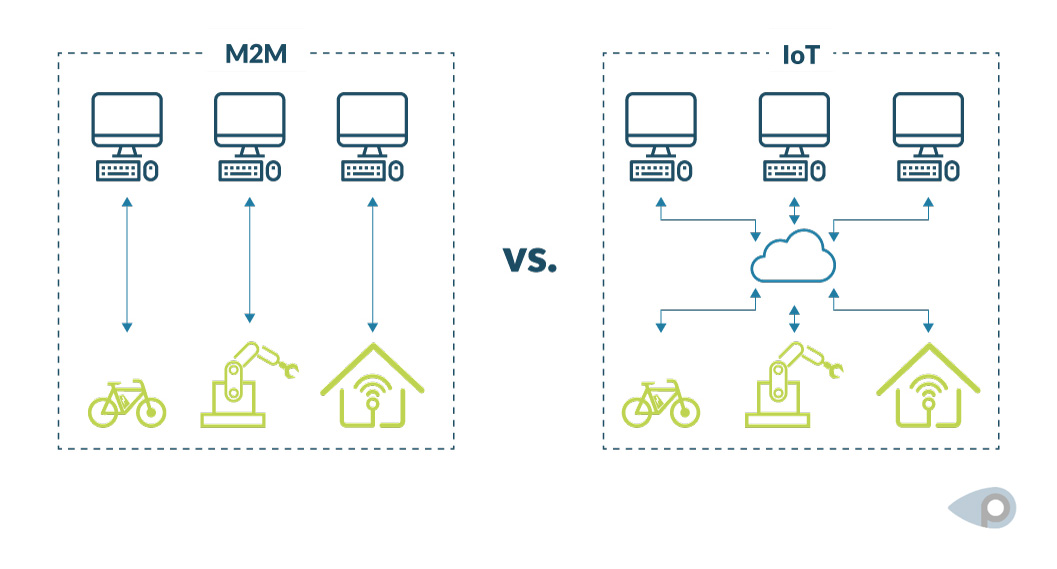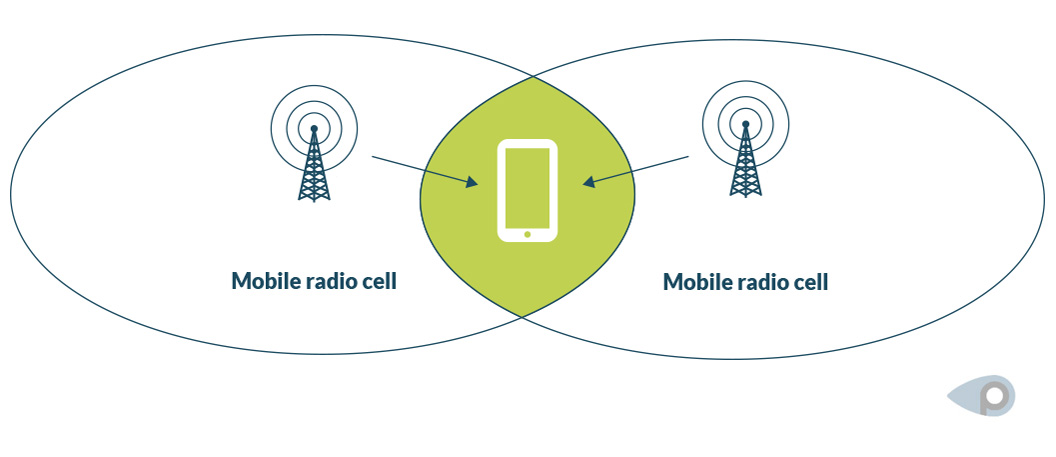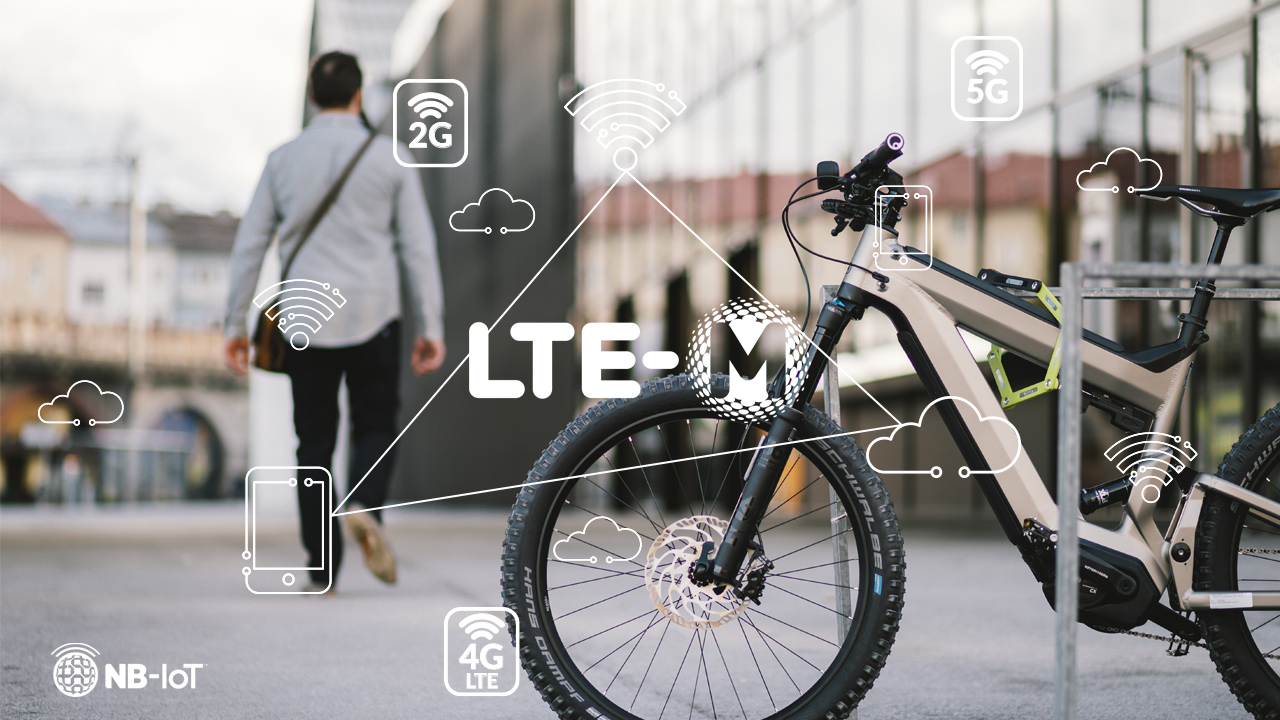- Free shipping from 220€The order of accessories (without BikeTrax) is excluded from the free shipping costs.
PowUnity explains, Special Topic, Top, Topics
LTE-M – the new form of IoT technology
Inhalt
LTE-M in a nutshell
- LTE-M or LTE-Cat-M1 stands for “Long Term Evolution for Machines”. The standard belongs to the Low Power Wide Area Networks (LPWAN), transmission technologies with a long range and low energy consumption.
- LTE-M is characterised by low latency, handover support, high building penetration and a long battery life. The standard is similar to Narrowband-IoT (Nb-IoT) in many respects. However, only LTE-M enables real-time tracking of mobile objects.
- Due to its seamless network coverage, 2G is currently still the better choice for theft protection for e-bikes and bicycles. In the near future, however, it will be replaced by LTE-M.
When people talk about IoT and mobile connectivity, LTE-M has been mentioned more and more frequently. This is no coincidence. The mobile communications standard is not only comparatively new. It is also characterized by several features that set new standards. This is particularly true in connection with IoT and mobile connectivity.
LTE-M: Long Term Evolution for Machines – a definition
LTE-M or LTE-Cat-M1 stands for Long Term Evolution for Machines. It is also known as Enhanced Machine-type Communications, or eMTC for short.
This is a mobile communications standard: NB-IoT, LTE-M, Sigfox, and Lora belong to the LPWAN – Low Power Wide Area Networks: networks intended for low energy consumption and high network coverage.
Like NB-IoT, LTE-Cat-M1 uses licensed spectrum. Both are based on the LTE network. Depending on the applications, this has advantages over Sigfox and Lora technologies, which use free frequency bands, first and foremost large network coverage, and long-term availability. We will return to this and the differences between the two standards later.

LTE-M and M2M – definition and differences
We have already mentioned it: LTE-Cat-M1 is explicitly designed for M2M and IoT. But what lies behind these terms and what is the difference?
Definition of M2M
The abbreviation M2M stands for machine-to-machine which means that machines or devices communicate with each other and automatically exchange information. The information exchange happens either directly or, for example, via a server.Sensors and microcontrollers play a central role in this communication.
M2M has already been established in the industry for quite some time.Here, the automated exchange of data is used, for example, to optimize production processes and energy management. M2M is also used for predictive maintenance.
Definition of IoT
The same thing happens with IoT as with M2M. Here, too, the focus is on automatic communication between devices or machines.
In some cases, however, the term Internet of Things is restricted to Internet-based networks and in which each device has its IP address. IoT solutions are, for example, smart home systems with connected lighting or heating solutions. However, the terms IoT and M2M are also often used as synonyms for each other.

LTE-Cat-M1 – a standard specifically for M2M/IoT
For smart devices or machines to communicate with each other, they need transmission paths, preferably without interfering cables. This is where wireless standards come into play. There are now quite a few of these – for all kinds of IoT applications.
If devices such as lighting solutions, heating, or entertainment systems are connected to the smart home, WLAN, Bluetooth Mesh, EnOcean, or Zigbee are used, for example. These wireless solutions can transport a lot of data.
However, they reach their limits when communication is required over certain distances, through building walls, and when long battery life is needed. The end is at the latest at 30 meters and thus at the own garden fence.
This brings us to the wide area networks already mentioned, to which the LTE-M technology belongs.
The main characteristics of LTE-M include the following:
- As a mobile network, it is ideal for communication over long distances.
- It even sends through thick building walls.
- Comparatively low latency 1
- For low to medium data volumes
- High battery life
- Low cost of devices
The impact these characteristics have on the use of LTE-M in the Internet of Things is clarified below.
NB-IoT and LTE-M technologies in comparison
The closest competitor of LTE-M is called NB-IoT (Narrowband-IoT/ also CAT-NB1/NB2). Because both technologies are often mentioned at the same time, we will discuss their key differences below.
Even though LTE-M and NB-IoT seem very similar at first glance, there are significant differences. These affect what the respective standard is used for.
What is NB-IoT?
Narrowband-IoT, like LTE-Cat-M1, was developed specifically for IoT. Like the latter, it uses the licensed frequency spectrum and can be integrated into existing infrastructures via a software update.
Applications LTE-M – examples
Typical applications of LTE-M include the following:
- Networking of streetlights: With the help of NB-IoT and corresponding sensors, streetlights can be switched on and off and dimmed from a distance. In some cases, they turn themselves down when there is no one around.
- Smart parking: Through the interaction of sensors, NB-IoT, and a special app, drivers can see available parking spots and directly head for them.
- Monitoring filling levels in the industry: In the industry, narrowband IoT can be used, for example, to monitor the filling levels of containers or the temperature of liquids. Since both are often located behind thick walls, the high building penetration of the technology comes into play.
- Remote meter reading: Due to its good network coverage and building penetration, NB-IoT is also suitable for reading meters remotely. The amount of electricity consumed is automatically transferred to the customer’s account.
And what about tracking moving things? Here we come to the differences between LTE-M and narrowband IoT.
NB-IoT and LTE-M technologies in comparison
Looking at LTE-Cat-M1 compared to NB-IoT (CAT-NB1/NB2), the following key differences stand out:
- Building penetration: Both technologies, NB-IoT and LTE-M are characterized by excellent building penetration. In a direct comparison, NB-IoT performs slightly better than LTE-M.
- Battery life: The situation is similar to battery life. Here, too, NB-IoT is slightly ahead.
- Data rate: LTE-M scores higher than NB-IoT with its higher data rates. While these are less than 100 kbps for narrowband IoT, LTE-M achieves 384-1000 kbps.
- Lower latency 1: For some IoT device applications (e.g., smart tracking), latency plays an important role. There is a clear difference between LTE-M and narrowband IoT. Only LTE-M is suitable for real-time transmission.
- Handover 2: So-called “handover” is another essential point in tracking mobile devices, especially when it comes to roaming across national borders. LTE-M maintains connectivity as devices get through different mobile cells. NB-IoT is different. Here, devices have to dial in each time.
- Voice transmissions: Lower latency and higher data rates enable voice transmissions over LTE-M. This feature is used, for example, in alarm systems.
- Costs: Modules for LTE-M have a somewhat more complex structure than those for NB-IoT and are, therefore, also more expensive.
There remains the issue of network coverage. In the recent past, LTE-M offers as much extended coverage as narrowband IoT, and both radio technologies have made significant progress.
However, it cannot quite compete with 2G technology yet. This plays a crucial role in roaming and tracking over long distances.
1The latency time (delay time) describes the time that elapses between the occurrence of an event and the occurrence of a visible reaction to it..

2Handover: When a mobile device moves to a new radio cell without the connection being interrupted, this is referred to as a “handover”.
Advantages and disadvantages of both cellular standards at a glance
There is no clear “better” or “worse” in the comparison of NB-IoT to LTE-M. Instead, the two solutions suit different IoT applications.
In contrast to NB-IoT, LTE-M offers better conditions for mobile device applications, while NB-IoT is better for stationary applications. Exceptions for IoT applications prove the rule, as always, and sometimes the difference lies within the details.

Applications LTE-M – examples
Lower latency, smooth “handover”, good network coverage as a low power wide area network – all these features make LTE-M (Long Term Evolution for Machines) applicable for the IoT technology related to mobile devices.
Typical applications of LTE-M include the following:
- Supply chain tracking: Using LTE-M, freight forwarders monitor where their cargo is in real-time. In addition, they receive other valuable information (e.g., temperature).
- Wearables: Smart watches with LTE-M transmit the owner’s live position.
- Patient monitoring: For patients and doctors, devices for patient monitoring are gaining importance. Through the Internet of Things and LTE-M, medical personnel remains aware of patients’ health status. They can respond quickly to emergencies, even if they are not in the hospital. One of the key requirements in this context is the live transmission of data.
- Elevators: Since LTE-M allows voice transmission, it is also used to make an emergency call in elevators.
By the way, there are also situations in which both LTE-M and narrowband IoT can be a good solution.
When tracking in logistics, only small amounts of data need to be sent, and not necessarily live. Narrowband IoT is ideal for this. As soon as the data volumes are larger and live localization is essential, LTE-M is the better alternative.
LTE-M: Suitable for GPS tracking of e-bikes?
GPS tracking has become the modern standard in security features for e-bikes (e.g., theft protection). While professional thieves can easily pick even expensive locks or hijack your bike with a delivery truck, GPS tracking allows you to
- see immediately on an app if your parked bike is moved without permission.
- Track the live location of a stolen e-bike and forward the GPS details to the police.
Both significantly increase the chances that you will prevent thefts or, in case, get your e-bike back after a such event. However, both only work with M2M or IoT. Here, too, the prerequisite is a suitable radio standard for transmitting data.
E-bike tracking with the Internet of Things demands a lot from the radio standard:
- The technology must enable data exchange over greater distances. For this reason, only a wide area network is worth considering.
- Ideally, there are no or hardly any latencies. This is the only way to track the live location of the e-bike. Since bike thieves like to take their stolen goods to other European countries, roaming is also important.
- Seamless network coverage guarantees that a stolen bike can be tracked anywhere, both domestically and abroad.
- Finally, good building penetration ensures that thick walls are no problem in tracking the e-bike.
High bandwidth is less important. After all, unlike many other IoT applications, tracking does not involve exchanging large amounts of data.
All of this sound familiar? The characteristics of LTE-Cat-M1 are almost congruent with the requirements described above, from low latency to building penetration.
There is only one limitation that ensures that this technology is currently not the first choice for e-bike tracking.
Why 2G is (still) better for GPS tracking
In order to use LTE-Cat-M1, the existing mobile network must be expanded, or a software update needs to be performed. In recent years, this has been made possible on a large scale. As a result, network coverage has developed rapidly.
For IoT connectivity and tracking, in particular, this means that smart tracking with LTE-M is no problem in or around cities. In some remote areas, the situation is still different. For GPS tracking as theft protection, this is a problem. After all, you need a network for this application, even if thieves transport your e-bike or motorcycle on remote country roads and store them in hidden barns.
That is why PowUnity currently relies on 2G. The standard has been around since the 1990s. This means that you benefit from seamless network coverage at home and abroad.
Important: The fact that 2G has lower data transfer rates is a problem if you want to download videos to your cell phone. However, it does not matter for tracking e-bikes.
Conclusion: LTE-M, a standard with a future
There is no question that, alongside narrowband IoT, Long Term Evolution for Machines, or LTE-Cat-M1, is one of the most important innovations in IoT connectivity. With its combination of low latencies, higher bandwidth than NB-IoT/CAT-NB1/NB2, good building penetration, and smooth handover, the standard is particularly suitable for data exchange with mobile devices and vehicles.
The only disadvantage is that the network for LTE-M is not yet available nationwide. This is a severe weakness when tracking e-bikes or motorcycles for theft protection. That is why 2G is currently still the better solution for GPS tracking of e-bikes.
LTE-M will therefore continue to gain importance in the future for the Internet of Things and thus also for smart tracking. The technology will also take on a pioneering role in theft protection in the future.
Share article!



 Deutsch
Deutsch